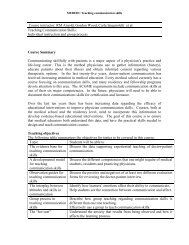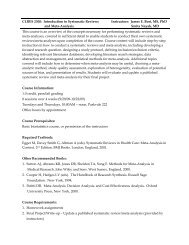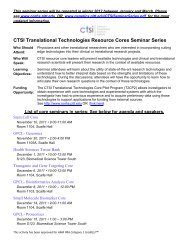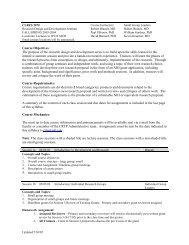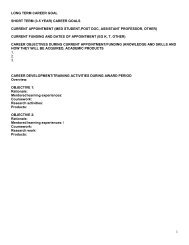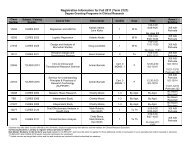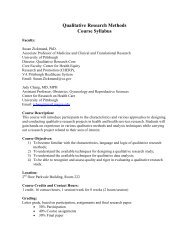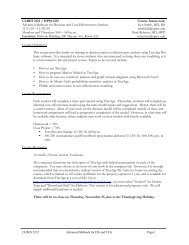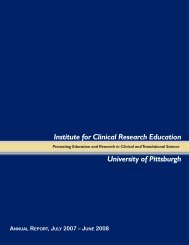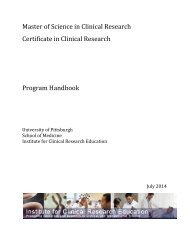1 CLRES 2800 Fundamentals of Clinical Trials - Institute for Clinical ...
1 CLRES 2800 Fundamentals of Clinical Trials - Institute for Clinical ...
1 CLRES 2800 Fundamentals of Clinical Trials - Institute for Clinical ...
Create successful ePaper yourself
Turn your PDF publications into a flip-book with our unique Google optimized e-Paper software.
<strong>CLRES</strong> <strong>2800</strong><strong>Fundamentals</strong> <strong>of</strong> <strong>Clinical</strong><strong>Trials</strong>Dates: 1/5/11-2/2/11Meeting time: MW 10:00-12:00(note: no class January 17 th )Location: VALE 305APhone contact: 412-246-6961Course Instructors:Charity G. Moore, PhDSunday Clark, ScDEmail addresses:moorecg@upmc.educlarks2@upmc.eduOverview and Objectives: <strong>Fundamentals</strong> <strong>of</strong> <strong>Clinical</strong> <strong>Trials</strong> course will provide in<strong>for</strong>mationon the first three phases (Phases I-III) <strong>of</strong> intervention/drug development and fundamentalcomponents <strong>of</strong> randomized clinical trials. A majority <strong>of</strong> lectures will focus on aspects <strong>of</strong> PhaseIII parallel group designs with discussions on topics including developing research questionsand defining endpoints, recruitment, randomization, blinding, data management & quality,monitoring, study closeout, and presentation/interpretation <strong>of</strong> results. The student will beintroduced to the Good <strong>Clinical</strong> Practice guidelines and the principles <strong>of</strong> planning andimplementing clinical research protocols including: ethical issues and regulatory imperativesdesigned to protect human subjects in clinical research, adverse event reporting,protocol/proposal development, and publications. We will use manuscripts <strong>of</strong> clinical trials andprotocols <strong>of</strong> completed studies to facilitate learning <strong>of</strong> concepts discussed in class.Responsibilities:• There will be reading assignments in the textbook and selected articles and guidelines.Readings <strong>of</strong> book chapters assigned in the syllabus are expected to be completed be<strong>for</strong>eclass.• Students will be assigned three homework assignments that will be graded. All homeworkassignments will be assigned with a due date. You are encouraged to work together on classprojects and homework assignments, but you should write up your results individually, i.e.very similar papers will not be accepted. Homework assignments are to be turned in at thebeginning <strong>of</strong> class on the due date. No assignments will be accepted via email.• Throughout the first and second modules <strong>of</strong> this course, you will be responsible <strong>for</strong>preparing a protocol <strong>for</strong> a clinical trial that will be turned in as a final project <strong>for</strong> bothmodules. You will be evaluated on your progress on this draft at the end <strong>of</strong> the first module.There are four draft protocol assignments during <strong>CLRES</strong> <strong>2800</strong>. Be sure to include the title<strong>of</strong> the study and primary research question on all protocol assignments. Draft protocolassignments should be turned in on separate documents from the regular homeworkassignment. We will be discussing some submitted protocol assignments in class.• Attendance and participation in class are required.• Evaluation criteria <strong>for</strong> this module will be based on completion <strong>of</strong> the written assignments,progress on your draft protocol, participation and attendance, and the final exam.Course RequirementsClass participation and attendance 5%Written assignments 50%Draft protocol 30%Final Exam 15%1
Course Grading Scale:For the computation <strong>of</strong> the final course grade as well as <strong>for</strong> the course assignments, thefollowing grading scale will be used:90 - 100 = A 80 – 85 = B 70 – 75 = C 60 – 65 = D86 – 89 = B+ 76 – 79 = C+ 66 – 69 = D+ < 60 = FNOTE: Homework assignments, course in<strong>for</strong>mation, and communication will be available athttp://courseweb.pitt.edu.Required Textbook: <strong>Fundamentals</strong> <strong>of</strong> <strong>Clinical</strong> <strong>Trials</strong> - Fourth Edition, Friedman LM,Furberg CD, DeMets DL., Springer, New York 2010.Other highly recommended textbooks to be used as references:<strong>Clinical</strong> <strong>Trials</strong>: A Practical Approach, 1996, Stuart J. Pocock, John Wiley & Sons<strong>Clinical</strong> <strong>Trials</strong>: Design, Conduct, and Analysis, 1986, Curtis L. Meinert, Ox<strong>for</strong>d<strong>Clinical</strong> <strong>Trials</strong>: A Methodologic Perspective, 2005, Steven Piantadosi, John Wiley & SonsWebsite resources:National <strong>Institute</strong>s <strong>of</strong> Health: www.clinicaltrials.govFood and Drug Administration: www.fda.govThe Cochrane Collaboration: www.cochrane.orgAcademic Integrity: Students in this course will be expected to comply with the University <strong>of</strong>Pittsburgh's Policy on Academic Integrity (http://www.provost.pitt.edu/info/ai1.html). Any studentsuspected <strong>of</strong> violating this obligation <strong>for</strong> any reason during the semester will be required to participate inthe procedural process, initiated at the instructor level, as outlined in the University Guidelines onAcademic Integrity. This may include, but is not limited to, the confiscation <strong>of</strong> the examination <strong>of</strong> anyindividual suspected <strong>of</strong> violating University Policy. Furthermore, no student may bring any unauthorizedmaterials to an exam, including dictionaries and programmable calculators.ADD ICRE SPECIFIC INFORMATION2
Course ScheduleDate : January 5, 2011Session 1 : Introduction to <strong>Clinical</strong> <strong>Trials</strong> Moore/ClarkAt the conclusion <strong>of</strong> this lecture, the student will be able to:1. Define the meaning <strong>of</strong> a clinical trial and describe different phases <strong>of</strong> drug development.2. Discuss the characteristics <strong>of</strong> well-<strong>for</strong>med research questions and hypotheses.3. Discuss different types <strong>of</strong> endpoints used in clinical trials and issues surrounding surrogateendpoints.4. Determine the study population <strong>for</strong> a clinical trial.Topics:1. Course overview2. Introduction to clinical trials and study protocols3. Brief overview study protocol features4. Research questions/hypotheses (FINER criteria)5. Intervention and study endpoints (primary, secondary, & surrogate)6. Study populationRequired reading:1. Friedman, Furberg, DeMets (FFD) Ch. 1 (Introduction to <strong>Clinical</strong> <strong>Trials</strong>), Ch 3 (What is theQuestion), Ch 4 (Study Population)2. Fleming TR, DeMets DL. (1996) Surrogate end points in clinical trials: are we being misled?Annals <strong>of</strong> Internal Medicine 125:605-613.Homework assignment 1: (1) Read one <strong>of</strong> the two selected articles and answer the assigned questions<strong>for</strong> the article you selected (see homework handout <strong>for</strong> specific details). (2) Read the assigned Phase Istudy and answer the assigned questions <strong>for</strong> the article. Identify a Phase II study in your area <strong>of</strong> interestand answer the assigned questions <strong>for</strong> the article (see homework handout <strong>for</strong> specific details). DueWednesday, January 12, 2011.Protocol assignment 1: Begin drafting your research question <strong>for</strong> the draft protocol that is due at theend <strong>of</strong> the module. For this homework assignment, turn in the title <strong>of</strong> your proposed project, the primaryresearch question and a clear definition and justification <strong>of</strong> the primary response variable. In addition,consider the study population and intervention, which will be part <strong>of</strong> the second homework assignment.Due Monday, January 10, 2011.Date : January 10, 2011Session 2:Drug Development,Pharmacokinetics/PharmacodynamicsIntroduction to Phase I & II <strong>Trials</strong>PoloyacMooreAt the conclusion <strong>of</strong> this lecture, the student will be able to:1. Describe the stages <strong>of</strong> drug development from pre-clinical to clinical.2. Describe important characteristics <strong>of</strong> PK/PD studies.1. Discuss the primary goal, general designs, and outcomes <strong>of</strong> Phase I studies.3. Discuss the primary goal, general designs, and outcomes <strong>of</strong> Phase II studies.Topics:1. Overview <strong>of</strong> drug development, pharmacokinetics, pharmacodynamics2. Overview <strong>of</strong> Phase I studies3. Overview <strong>of</strong> Phase II studiesRequired reading:3
1. Zhou Y (2004) Choice <strong>of</strong> designs and doses <strong>for</strong> early phase trials. Fundamental & <strong>Clinical</strong>Pharmacology 18:373-378.2. Stallard N, Whitehead J, Todd S, Whitehead A (2001) Stopping rules <strong>for</strong> Phase II studies. BritishJournal <strong>of</strong> <strong>Clinical</strong> Pharmacology 51:523-5293. Geller NL (1984). Design <strong>of</strong> phase I and II clinical trials in cancer: A statistician’s view. CancerInvestigation 2(6) 483-491.Protocol assignment 2: Describe the study population and intervention <strong>for</strong> your proposed project.Due Wednesday, January 12, 2011.Due today: Protocol Assignment 1Date: January 12, 2011Session 3: Review <strong>of</strong> research questions (protocols) Class discussionIntroduction to Phase III <strong>Trials</strong>Ethics in <strong>Clinical</strong> <strong>Trials</strong>ClarkAt the conclusion <strong>of</strong> this lecture, the student will be able to :1. Discuss the advantages and disadvantages <strong>of</strong> randomized design.2. Describe the main features <strong>of</strong> a study protocol.3. Discuss ethical issues surrounding intervention studies.4. Discuss the history <strong>of</strong> research ethics.5. Describe important compenents <strong>of</strong> a well-designed in<strong>for</strong>med consent <strong>for</strong>m.6. Discuss important concepts in obtaining in<strong>for</strong>med consent.Topics:1. Introduction to Phase III trials2. Protocol development guidelines3. Ethical issues in clinical trials4. International Harmonization Conference & Good <strong>Clinical</strong> Practice5. In<strong>for</strong>med consent guidelines6. Regulatory environment; roles <strong>of</strong> IRB, OHRP, FDA7. University <strong>of</strong> Pittsburgh, CTSI, Regulatory Knowledge and Support Core:http://www.ctsi.pitt.edu/content.asp?id=1448Required reading:1. FFD Chapter 2 (Ethics) and Chapter 5 (Basic study design)2. Nuremburg Code http://ohsr.od.nih.gov/nuremberg.php3,3. Belmont Report http://ohrp.osophs.dhhs.gov/humansubjects/guidance/belmont.htm4. ICH/GCP http://www.fda.gov./cder/guidance/iche6.htm (Sections 1-4, and Section 6)Homework assignment 2: (1) Read the assigned Brad<strong>for</strong>d Hill article and answer the assignedquestions <strong>for</strong> the article (see homework handout <strong>for</strong> specific details) (2) In<strong>for</strong>med consentDue Wednesday, January 19, 2011.Protocol assignment 3: Draft a 1-2 page document <strong>of</strong> the Background and Significance section <strong>for</strong>your protocol. Due Wednesday, January 19, 2011. Note: Make two copies <strong>for</strong> turning in one to instructorsand one <strong>for</strong> peer review. Background and Significance will be critiqued by classmate. Critiques will be dueMonday, January 24, 2011.Due today: Homework assignment 1 & Protocol assignment 2Date: January 19, 2011Session 4 Review <strong>of</strong> population and intervention (protocols) Class discussionImportant Procedures in <strong>Clinical</strong> <strong>Trials</strong>MooreAt the conclusion <strong>of</strong> this lecture, the student will be able to :1. Compare the different types <strong>of</strong> randomization in clinical trials.2. Discuss importance <strong>of</strong> blinding and issues pertaining to blinding.4
3. Understand appropriate situations <strong>for</strong> using a placebo-controlled trial.4. Describe the components <strong>of</strong> a study assessement calendar.Topics:1. Randomization2. Intent-to-treat concept3. Blinding/Masking4. Placebo controls5. Study calendarRequired reading:1. FFD Ch 6-7 (randomization, blindness)Protocol assignment 4: For your draft protocol, describe the follow components: (1) Secondaryresearch questions and response variables; (2) Recruitment plan; (3) A table with study measurements(baseline, primary and secondary outcomes); (4) Secondary outcome(s) and brief description <strong>of</strong> each; (5)Intervention allocation; (6) Randomization scheme and justification; (7) Type <strong>of</strong> blinding to be used andjustification; (8) Study assessment calendar. Due Wednesday, January 26, 2011.Due today: Homework assignment 2 &: Protocol Assignment 3.Date: January 24, 2011Session 5: Study Coordination & Recruitment BelnapData Management and CoordinationRubioAt the conclusion <strong>of</strong> this lecture, the student will be able to :1. Describe the role <strong>of</strong> a research coordinator.2. Understand the components <strong>of</strong> successful recruitment.3. Describe the factors involved in developing a well designed clinical research <strong>for</strong>m.4. Discuss the different types <strong>of</strong> data management systems used in clinical trials.5. Describe methods to minimize poor data quality.6. Discuss the types <strong>of</strong> adverse events in clinical trials and methods <strong>of</strong> monitoring them.7. Discuss methods <strong>of</strong> measuring/monitoring adherenceTopics:1. Recruitment and retention2. Barriers to participation in research3. Adverse event reporting4. Adherence5. <strong>Clinical</strong> research <strong>for</strong>ms & data collection6. Data management & quality assuranceRequired Reading: FFD Ch 10 (recruitment), Ch 11 (Data Collection and Quality Control), Ch 12(Assessing and Reporting Adverse Effects), & Ch 14 (Participant Adherence)Homework assignment 3: (1) Read the assigned article and answer the assigned questions <strong>for</strong> thearticle. (2) Identify a published clinical trial in your area <strong>of</strong> interest and answer the assigned questions <strong>for</strong>the article (see homework handout <strong>for</strong> specific details). Due Monday, January 31, 2011.Due today: Background and Significance classmate critiquesDate: January 26, 2011Session 6: Data and Safety Monitoring Yasko/AlexanderIntroduction to Interim AnalysesMooreAt the conclusion <strong>of</strong> this lecture, the student will be able to :1. Describe appropriate procedures <strong>for</strong> study monitoring.2. Discuss the importance and role <strong>of</strong> the DSMB.5
3. Describe the aim and general approach <strong>of</strong> interim analysis.4. List the four major reasons <strong>for</strong> terminating a trial earlier than scheduled.5. Describe what is involved in closing out a study.Topics:1. Study monitoring2. Understand the role <strong>of</strong> a data and safety monitoring board (DSMB)3. Introduction to interim analysis4. Early terminationRequired reading:1. FFD Ch 16 Monitoring Response Variables (pp. 246-259)2. ICH/GCP: http://www.fda.gov./cder/guidance/iche6.htm (Sections 5: Sponsor, 7: Investigator’sBrochure, and 8: Essential Documents <strong>for</strong> the Conduct <strong>of</strong> a <strong>Clinical</strong> Trial)Draft Protocol: Combine each <strong>of</strong> the components <strong>of</strong> your draft protocol that have been included in yourprotocol assignments. Turn in a “draft” version <strong>of</strong> your complete protocol with all required sections exceptthe sample size and statistical analysis section. Due: Monday, February 7, 2011.Due today: Protocol assignment 4Date: January 31, 2011Session 7: Multicenter <strong>Trials</strong> BostReporting and interpreting study resultsMooreAt the conclusion <strong>of</strong> this lecture, the student will have learned about :1. Discuss methods <strong>of</strong> handling protocol deviations.2. The reasons <strong>for</strong> conducting <strong>of</strong> multicenter trials.3. Guidelines <strong>for</strong> reporting results <strong>of</strong> clinical trials4. Examples <strong>of</strong> authorship guidelines in protocolsTopics:1. Protocol deviations2. Multicenter trials3. Reporting study results & Authorship guidelines in protocolsRequired Reading1. FFD Ch 19 (Reporting and Interpreting <strong>of</strong> Results) & 20 (Multicenter <strong>Trials</strong>)2. http://www.consort-statement.org (Click on CONSORT Statement, then in box on the right clickon the JAMA article)3. Fontanarosa PB, DeAngelis CD. (2008) Publication <strong>of</strong> clinical trials in JAMA. JAMA 299 : 95-96.4. Flanagin A, Fontanarosa PB, DeAngelis CD. Authorship <strong>for</strong> research groups. JAMA.2002;288(24):3166-3168.Due today: Homework assignment 3Date: February 2, 2011Session 8: Final ExamProtocol discussionReview recruitment/allocation/blinding Class discussionDON’T FORGET: Februrary 7, 2011 (first day <strong>of</strong> Module 2) Draft Protocol Is Due!!6




